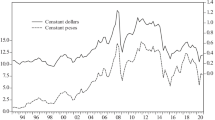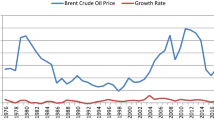Abstract
The effect of oil prices on countries’ economic activity has been the center of attention for decades. The empirical link between oil prices and economic activity has been steadily investigated during this time period but the measured outcomes have revealed mixed results and been inconsistent. This study examines the effect of oil prices on economic activity for Brazil, Russia, India, China, and South Africa (BRICS) and Group of Seven (G7) countries in both short-run and long-run relationships by estimating a maximum likelihood structural vector autoregression model. The model shows that a positive shock to oil prices tends to affect the monetary aggregate in Brazil, Canada, France, Germany, and Russia. The effect on interest rate spread is most significant in India and Russia. Impulse response functions display almost no effect on the gross domestic product in the US and China. A positive response on the consumer price index is observed mostly for developed countries. The response of real exchange rate reveals a positive effect on all countries in varying degrees, with the exception of the US and South Africa. Finally, Granger causality tests were conducted with proper allowance for the non-stationarity of the data. The findings illustrate that the Russian economy is among the economies that are most significantly affected by oil price fluctuations for almost all the selected variables. The models also reveal that the effect of oil price shocks on the US’s and China’s economic activities is only limited to the effect on real exchange rates. Other variables show no or limited reactions to oil prices. We also used the Markov switching maximum likelihood vector autoregression models, which reveals similar results.



Similar content being viewed by others
Notes
See Leopold, (2016) for a comprehensive literature survey about supply chain management of oil utilization.
Compare Kilian (2008) for similar identification scheme.
Alternatively, we applied 3-state MS VAR models. Similar results were obtained, revealing significant oil price effects on the related model variables. The results are available on request.
References
Alvarez-Ramirez J, Alvarez J, Solis R (2010) Crude oil market efficiency and modeling: insights from the multiscaling autocorrelation pattern. Energy Econ 32:993–1000
Antonietti R, Fontini F (2019) Does energy price affect energy efficiency? Cross-country panel evidence. Energy Policy 129:896–906
Apergis N, Loomis D, Payne JE (2010) Are fluctuations in coal consumption transitory or permanent? Evidence from a panel of US states. Appl Energy 87(7):2424–2426
Artis M, Krolzig HM, Toro J (2004) The European business cycle. Oxf Econ Pap 56:1–44
Bai J, Perron P (1998) Estimating and testing linear models with multiple structural changes. Econometrica 66:47–78
Benhmad F (2012) Modeling nonlinear Granger causality between the oil price and U.S. dollar: a wavelet based approach. Econ Model 29(4):1505–1514
Bjørnland HC, Larsen VH, Maih J (2018) Oil and macroeconomic (in) stability. Am Econ J Macroecon 10(4):128–51
Boldin MD (1996) A check on the robustness of Hamilton’s Markov switching model approach to the economic analysis of the business cycle. Stud Nonlinear Dyn Econ 1:35–46
Cologni A, Manera M (2009) The asymmetric effects of oil shocks on output growth: a Markov switching analysis for the G7 countries. Econ Model 26(1):1–29
Filardo A (1994) Business cycle phases and their transitional dynamics. J Bus Econ Stat 9:299–308
Goodwin TH (1993) Business cycle analysis with a Markov switching model. J Bus Econ Stat 11:331–339
Greene WH (2012) Econometric analysis, 7th edn. Pearson, London
Hamilton JD (1989) A new approach to the economic analysis of nonstationary time series and the business cycle. Econ J Econ Soc 57:357–384
Hamilton JD (1994) Time series analysis, 1st edn. Princeton University Press, Princeton
Hamilton JD (1996) This is what happened to the oil price-macroeconomy relationship. J Monet Econ 38(2):215–220
Hasanov M, Telatar E (2011) A re-examination of stationarity of energy consumption: evidence from new unit root tests. Energy Policy 39(12):7726–7738
Hooker MA (1996) What happened to the oil price-macroeconomy relationship? J Monet Econ 38(2):195–213
Huang B, Hwang MJ, Peng H (2005) The asymmetry of the impact of oil price shocks on economic activities: an application of the multivariate threshold model. Energy Econ 27(3):455–476
Kilian L (2008) The economic effects of energy price shocks. J Econ Lit 46(4):871–909
Krolzig HM (1996) Statistical analysis of cointegrated VAR processes with Markovian regime shifts. Humboldt Universitaet. Sonderforschungsbereich 373, pp 1996–2025
Lee K, Ni S, Ratti RA (1995) Oil shocks and the macroeconomy: the role of orice variability. Energy J 16(4):39–54
Leopold A (2016) Energy related system dynamic models: a literature review. Cent Eur J Oper Res 24(1):231–261
MacKinnon JG (1996) Numerical distribution functions for unit root and cointegration tests. J Appl Econ 11(6):601–618
Mishra V, Smyth R (2014) Convergence in energy consumption per capita among ASEAN countries. Energy Policy 73:180–185
Naccache T (2010) Slow oil shocks and the weakening of the oil price-macroeconomy relationship. Energy Policy 38(5):2340–2345
Narayan P, Smyth R (2007) Are shocks to energy consumption permanent or temporary? Evidence from 182 countries. Energy Policy 35(1):333–341
Pesaran S, Smith Y (2000) Structural analysis of vector error correction models with exogenous I(1) variables. J Econ 97:293–343
Pesaran H, Shin Y (1998) Generalized impulse response analysis in linear multivariate models. Econ Lett 58:17–29
Phillips PCB, Perron P (1988) Testing for a unit root in time series regression. Biometrika 75(2):335–346
Rahman S, Serletis A (2010) The asymmetric effects of oil price and monetary policy shocks: a nonlinear VAR approach. Energy Econ 32(6):1460–1466
Ratti R, Vespignani J (2013a) Why are crude oil prices high when global activity is weak? Econ Lett 121(1):133–136
Ratti R, Vespignani J (2013b) Crude oil prices and liquidity, the BRIC and G3 countries. Energy Econ 39:28–38
Ratti R, Vespignani J (2016) Oil prices and global factor macroeconomic variables. Energy Econ 59:198–212
Tang W, Wu L, Zhang Z (2010) Oil price shocks and their short- and long-term effects on the Chinese economy. Energy Econ 32(1):S3–S14
Tiwari AK (2013) Oil prices and the macroeconomy reconsideration for Germany: using continuous wavelet. Economic Model 30:636–642
Wang Z, Wei W, Luo J, Calderon M (2019) The effects of petroleum product price regulation on macroeconomic stability in China. Energy Policy 132:96–105
Author information
Authors and Affiliations
Corresponding author
Additional information
Publisher's Note
Springer Nature remains neutral with regard to jurisdictional claims in published maps and institutional affiliations.
Rights and permissions
About this article
Cite this article
Kilic, E., Cankaya, S. Oil prices and economic activity in BRICS and G7 countries. Cent Eur J Oper Res 28, 1315–1342 (2020). https://doi.org/10.1007/s10100-019-00647-8
Published:
Issue Date:
DOI: https://doi.org/10.1007/s10100-019-00647-8




